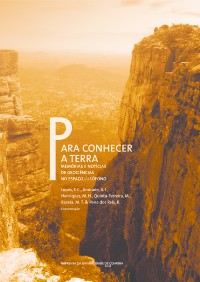Please use this identifier to cite or link to this item:
https://hdl.handle.net/10316.2/31434| Title: | Geologia, geocronologia e geoquímica do granito de Inchope (Moçambique) | Other Titles: | Geology, geochronology and geochemestry of the inchope granite (Mozambique) | Authors: | Manjate, V. A. Tassinari, C. C. G. |
Keywords: | Orogenesis;Geochronology;Model age;Isochron age;Crystallization;Orogênese;Geocronologia;Idade modelo;Idade isocrônica;Cristalização | Issue Date: | 2012 | Publisher: | Imprensa da Universidade de Coimbra | Journal: | http://hdl.handle.net/10316.2/24406 | Abstract: | The Gondola-Nhamatanda region is located at the border between the provinces
of Manica and Sofala, central part of Mozambique. It is geologically inserted in the Bárue Complex
(Chimoio Group). The Bárue complex is composed of the Macossa and Chimoio supracrustal
groups intruded by plutonic rocks of various compositions. The rocks samples of the work area were studied in terms of petrography; geochemistry of major and trace elements; geochronology and isotope geochemistry by the follow methods: U-Pb in zircon, Rb-Sr and Sm-Nd in whole
rock, and Rb-Sr in minerals for the Inchope granite. This study allowed determining the lithotypes
that intruded the Chimoio Supracrustal Group, the crystallization and differentiation ages
of the magmas that formed the protoliths, and the tectonic framework. The studied rocks basically
are calc-alkaline and peraluminous. They have been crystallized in the Mesoproterozoic (U-Pb
and Rb-Sr ages) from Paleoproterozoic protoliths (TDM = 2.4 – 2.4Ga). The isotopic data suggest
that they have been generated by partial melting that probably involved the mixture (eNd negative
values) of Archean/Paleoproterozoic crust and Mesoproterozoic magma at 1100 Ma, and suffered reworking during the Gondwana amalgamation (Pan-African Orogeny) A região de Gondola-Nhamatanda localiza-se na parte limítrofe entre as províncias de Manica e Sofala, centro de Moçambique. Ela está geologicamente inserida no complexo de Bárue (Grupo de Chimoio). O Complexo de Bárue é composto pelos grupos Supracrustais de Macossa e Chimoio intrudidos por rochas plutônicas de várias composições. As amostras de rochas da área de trabalho foram estudadas em termos de petrografia; geoquímica de elementos maiores e traço; geocronologia e geoquímica isotópica pelos métodos U-Pb em zircão, Rb-Sr e Sm-Nd em rocha total e Rb-Sr em minerais para o Granito de Inchope. Este estudo permitiu determinar os litotipos que intrudiram o Grupo Supracrustal de Chimoio, suas idades de cristalização e de diferenciação dos magmas que formaram seus protólitos e ainda, o enquadramento tectônico. As rochas estudadas são basicamente calci-alcalinas peraluminosas. Elas cristalizaram no Mesoproterozoico (idades U-Pb e Rb-Sr) a partir de protólitos Paleoproterozoicos (TDM = 2,4 – 2,3 Ga). Os dados isotópicos sugerem que estas rochas foram geradas por fusão parcial que provavelmente envolveu mistura (valores negativos de eNd) da crusta Arcaica/Paleoproterozoica e magma mesoproterozoico a 1100 Ma e sofreu retrabalhamento durante a aglutinação do Gondwana (Orogenia Pan-Africana) |
URI: | https://hdl.handle.net/10316.2/31434 | ISBN: | 978-989-26-0534-0 (PDF) | DOI: | 10.14195/978-989-26-0534-0_24 | Rights: | open access |
| Appears in Collections: | Para conhecer a Terra: memórias e notícias de Geociências no espaço lusófono |
Files in This Item:
| File | Description | Size | Format | |
|---|---|---|---|---|
| 24-para_conhecer_a_terra_artigo.pdf | 1.05 MB | Adobe PDF |  |
Items in DSpace are protected by copyright, with all rights reserved, unless otherwise indicated.
